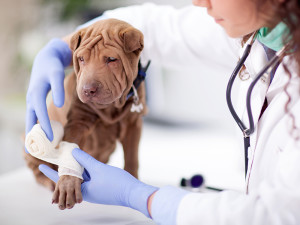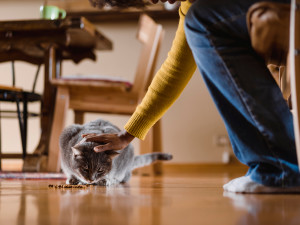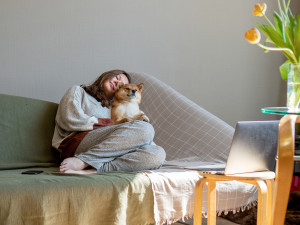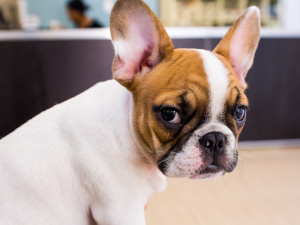Cats, Priceless. Cat Parenthood, Not So Much
A rundown of the most common cat expenses.

share article

Your pet wants you to read our newsletter. (Then give them a treat.)
Your kitten’s first meow, pounce, or warmhearted headbuttopens in a new tab? Priceless. Some other aspects of cat parenthood? Not exactly complimentary. Many new cat parents mistake low maintenance for low budget, and are surprised to find that the costs associated with keeping a cat healthy add up quickly.
According to veterinarian Dr. Annette Louviere, “It’s easy for pet parents to focus on the essentials, like litter boxesopens in a new tab, food bowlsopens in a new tab, cat scratchersopens in a new tab, and toysopens in a new tab, but we have a tendency to less often prepare for undesirable events, like veterinary emergencies.” That’s why it’s so important to make a game plan before you grow your family by one kitten (or two) — it’ll ease your stress knowing you’re prepared for anything life throws at you. Below, a rundown of the most common cat expenses, what to prioritize in those first few weeksopens in a new tab, and how to budget for future expenses.
First, find your dream cat.
The amount you spend on your cat is going to vary pretty dramatically depending on where you get them. If you buy a purebred cat from a breeder, chances are you’ll end up paying over a grand. If you adoptopens in a new tab, the adoption fees set by the shelter will depend on the cat’s location, age, and size; shelters also take into account whether a cat is spayed or neutered when factoring in the price.
At larger-capacity city shelters, adoption feesopens in a new tab range from $50 for an adult cat to $175 for a kitten, whereas adopting from an independent breeder can cost upwards of $750. There are tons of incredible cats of all ages available for adoption that won’t cost more than your last facial, so we highly recommend going that route. Plus, you can pocket the extra money you didn’t spend to acquire your new best friend and put it towards their college fund (aka vet bills) for later down the line.
Next, schedule the first vet visit.
Well, that didn’t take long. Dr. Shines recommends a wellness examopens in a new tab within the first few days of adoption: “It’s important to get a baseline or a bill of health so you have a good starting point.” If your cat is not already spayed or neutered, surgery costs are based on sex and size (neutering a male cat is cheaper because it’s less invasive), but local low-cost clinics can offer better deals if you’re eligible. Some pet insurance plans will cover spay/neuter surgeries, but it really pays out in an emergency. Quotes will differ for a random-bred kitten (with no predisposed genetic health concerns) and a senior catopens in a new tab with pre-existing conditions.
Pet insurance plansopens in a new tab can greatly reduce the price you pay out of your wallet for your pet’s health. CareCreditopens in a new tab is another useful tool: It essentially works as a wellness and health-only credit card that allows you to pay for your pet’s vet bill on a payment plan. If you make payments on time within your payment plan period of six, 12, 18 or 24 months on a purchase of $200 or more, CareCredit will not add interest, making it a more sound financial decision than traditional credit. CareCredit can be used for routine pet care — such as diagnostics, check-ups, parasitesopens in a new tab, and spay/neuter surgeries — as well as emergency care.
Rabies vaccines cost around $20. Your kitten will need a rabies vaccineopens in a new tab at around 16 weeks and will require another shot a year from then. After that, they’ll require a booster every three years. The costs of most other vaccines (like Feline Leukemiaopens in a new tab and Feline Distemper combo and Rabies) range from $30-$75. Kittens will need three sets of viral vaccines but check your cat’s records first to see what vaccines the shelter may have already provided. Other vaccines are recommended on a case-by-case basis, determined by your location and your cat’s lifestyle.
These are annual estimates…
Wellness exam (twice a year): $50-100
Spay/neuter surgery: $125-900
Monthly flea/tick and heartworm preventatives (replenished quarterly): $30-50
Vaccinations: $105-430+
Bloodwork (CBC) including biochemistry panel: $55-175
SNAP Feline Triple Test (screens for FELV, FIV & Heartworm antigen): $25-40
Microchipopens in a new tab and implantation: $40-50
Fecal sample: $15-60
Pet insurance: $25-100+
Emergency vet visits (depending on the severity of the issue): $250-1,500+
Then, stock up on standard supplies.
A four-pound bag of dry kibble starts at around $25 and will last about three months for a small cat. Plus, many veterinarians recommend mixing in or feeding your cat exclusively wet food, which will run you about $2 per can for the good stuff. It’s all uphill from there. The higher the quality of the cat foodopens in a new tab, the more expensive it will be. And if your cat has allergiesopens in a new tab or health concerns that require a special diet for, the price tag continues to go up. The same goes for cat treats, and you’ll probably spend more on treats in the first year, using them to train your kitten. Litter and litter liners are two items you can never have too many of. Regardless of the amount of cats in your household, you can expect them to pee or poop every couple of hours when they aren’t sleeping. Do the math!
Foodopens in a new tab (per month): $15-50+
Treatsopens in a new tab (per package): $5-10
Litter (per 40lb box): $15-40
Litter box: $10-150+
After that, itemize your support system.
Some of these expenses are arguably the most important ones. Perhaps this isn’t your first rodeo and you already have a perfectly good litter box sitting in the basement; if not, it might be time to go down a Yelp review rabbit hole and find a new one. If you work from home, you probably don’t need to worry about paying someone to stop in and play with your cat, but if you travel often it’ll be important to find a trusted sitteropens in a new tab. And remember, boarding costs can vary based on quality — do you want your cat spending the night at Holiday Inn or Ace Hotel?
Basic groomingopens in a new tab supplies: $10-15
Cat sitter or kennel: $20-45+
Last but not least, snag all the fun stuff.
Namely, all the things on your Pinterest board. Of course, the cost of these items will depend on your cat’s preferences (and your style) but we ballparked it.
Bedopens in a new tab: $15-200+
Scratching post: $12-275+
Nail clippers: $5-20
Collaropens in a new tab: $10-50
Toys: $10-100+
Food and water bowls: $4-50
Armed with this shopping list, you should be all set to start stocking up!

Avery Felman
Avery is a writer and producer. She has written for numerous publications, including Refinery29, BuzzFeed, and V Magazine. When she’s not at her computer, you can find her reading, practicing her Greek on Duolingo, and delving into the Sex and the City discourse. She lives in Brooklyn, New York with her husband and their cat, Chicken, who rules with an iron fist.
Related articles
![A hand reaching towards a cat peaking out of a cage.]() opens in a new tab
opens in a new tab10 Questions to Ask a Shelter About an Adoptable Cat
From medical history to adoption fees to litter preferences, here is everything you need to know.
![shiba inu snuggling on couch with woman]() opens in a new tab
opens in a new tabMoney Talks: The Dollars of Dog Parenthood
We crunched some numbers and yup, they’re worth every penny.
![French bulldog puppy looking scared at vet]() opens in a new tab
opens in a new tab10 Things to Ask at Your First Vet Visit
There are no stupid questions — well, when it comes to your dog’s health.





